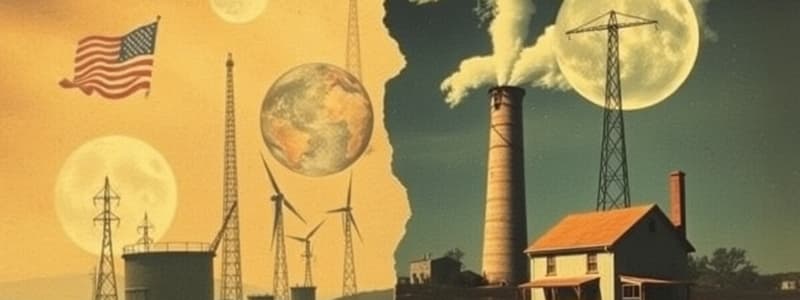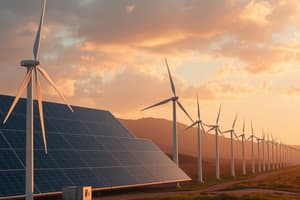Podcast
Questions and Answers
What is the potential energy of a 98kg object that is 10 meters above the ground?
What is the potential energy of a 98kg object that is 10 meters above the ground?
- 98 Joules
- 980 Joules
- 9800 Joules (correct)
- 98000 Joules
What type of energy is stored in the bonds of sugar molecules?
What type of energy is stored in the bonds of sugar molecules?
- Sound energy
- Potential energy (correct)
- Thermal energy
- Kinetic energy
The equation 'Pe = (9.8) * N + H' represents which type of energy?
The equation 'Pe = (9.8) * N + H' represents which type of energy?
- Chemical potential energy
- Elastic potential energy
- Kinetic energy
- Gravitational potential energy (correct)
What is the primary source of energy that is needed to burn food?
What is the primary source of energy that is needed to burn food?
Which of the following is NOT a direct source of energy for living organisms?
Which of the following is NOT a direct source of energy for living organisms?
Flashcards
Gravitation
Gravitation
The force of attraction between two masses.
Potential Energy
Potential Energy
Energy stored in an object due to its position or configuration.
Elastic Potential Energy
Elastic Potential Energy
Energy stored in elastic materials as a result of their stretch or compression.
Chemical Potential Energy
Chemical Potential Energy
Signup and view all the flashcards
Energy Needed to Burn Food
Energy Needed to Burn Food
Signup and view all the flashcards
Study Notes
Energy and Energy Resources
- Energy is the ability to cause change
- All objects contain energy, some more than others
- The Sun is a major energy resource
- Energy in plants and energy from the Sun are related
- Energy is the ability to cause change
- Examples of energy resources include cars, plants and the sun
- Energy can be transformed from one form to another.
Get Ready to Read
- A fast-moving baseball has more kinetic energy than a slow-moving one.
- A book sitting on a shelf has energy.
- Energy can change from one form to another.
- The total amount of energy decreases when something rises straight up
- Nuclear power plants release pollutants as they transform nuclear energy
Lesson 1: Forms of Energy
- Energy is the ability to cause change
- Kinetic energy - energy of motion
- Potential energy - stored energy
- Different forms of energy include: sound, thermal, and radiant
- Energy is related to work
- A camera that detects temperature can be used to measure radiant energy
Launch Lab
- Changes in matter can be observed, such as changes in temperature
- Energy is the ability to cause change
- Energy causes changes in motion and position of objects
- Examples of energy include fireworks exploding, plants growing, and hammers hitting nails
Kinetic Energy-Energy of Motion
- Kinetic energy depends on speed and mass
- Faster objects have more kinetic energy
- Objects with higher mass have more kinetic energy
Potential Energy-Stored Energy
- Energy can be stored, even if objects aren't moving.
- Stored energy is known as Potential energy
- Types of potential energy include gravitational potential, elastic potential, and chemical potential.
Gravitational Potential Energy
- Gravitational potential energy exists between an object and Earth
- This energy depends on weight and height
- Higher positions mean more potential energy
Elastic Potential Energy
- Elastic potential energy is stored in objects that are bent or stretched (like rubber bands)
Chemical Potential Energy
- Chemical energy is stored in the chemical bonds between atoms
- Stored in substances like foods, gasoline, and other substances
Energy and Work
- Energy is transferred when work is done
- Applying a force over distance is considered work
- Energy is transferred from doing work
- Objects with energy can do work
Lesson 1: Energy Review
- Energy is the ability to cause change
- There are different forms of energy
- Energy can be transferred in different ways
- Gravitational Potential Energy increases when you lift something
- Forces cause change, and applying a force over distance represents work
Lesson 2: Energy Transformations
- The Law of Conservation of Energy states energy is neither created nor destroyed, but transformed from one form to another
- Transformations involve conversions of energy between different forms
Friction and Energy
- Friction transforms mechanical energy to thermal energy
- Friction is a force that resists movement
- Surfaces rubbing against each other release thermal energy
- Lubircants reduced friction
- Lubricants can be used to reduce friction
Lesson 2 Review
- Energy transformations are possible due to the law of Energy conservation
- Applying brakes on a bicycle is an example of energy transformation from one form to another
- Types of energy include thermal, radiant, mechanical, and electric
- Energy resources can be transformed into other forms of energy
Lesson 3: Energy Resources
- Nonrenewable resources are used faster than they are replaced
- Renewable resources are replaced as fast as, or faster than, they are used
- The Sun is an inexhaustible energy resource
- Energy conservation involves using energy more efficiently
Fossil Fuels
- Fossil fuels are nonrenewable resources
- Often burned to produce energy (e.g., coal, natural gas etc.)
- These resources are finite, and are used more quickly than they are produced, making conservation important
- These fuels formed from remains of ancient organisms over millions of years
- Coal, natural gas, and petroleum are forms of fossil fuels
Hydroelectric Power Plants
- Hydroelectric power plants transform potential energy of falling water into electric energy
- Dams create reservoirs allowing water to fall, converting stored potential energy into kinetic energy
- These plants use falling water to generate electricity without emitting pollutants into the air
- Dams can disrupt wildlife
Solar Energy
- Solar energy is radiant energy from the Sun
- Solar energy can be converted directly to electrical energy by solar cells
- Solar energy is an inexpensive renewable resource
Wind Energy
- Wind energy is another renewable energy resource
- Modern wind turbines convert wind energy into electric energy through the kinetic energy of spinning propellers or windmills
- These are practical in areas with higher average wind speeds
- Wind turbines produce no pollution
Biomass
- Biomass is matter that comes from plants and living organisms
- Biomass is a renewable energy resource
- Biomass fuels (e.g., wood, peat, manure) can be burned
Geothermal Energy
- Geothermal energy is heat from inside Earth
- These energy sources can be used for electricity production in areas where geothermal energy is available
- Geothermal energy produces steam that spins turbines to produce useful energy or electricity
MiniLab: Energy Resources
- Identifying how energy resources are used in power production
- Analyzing energy use and conservation in different ways
- Researching different types of resources and how they are used
Chapter 5 Review
- Energy is the ability to cause change and can take many forms
- Energy transformations can be observed in everyday situations like a book falling
- Energy can neither be created nor destroyed
- Resources such as fossil fuels are nonrenewable
- There are advantages and disadvantages to using different types of energy
Studying That Suits You
Use AI to generate personalized quizzes and flashcards to suit your learning preferences.




